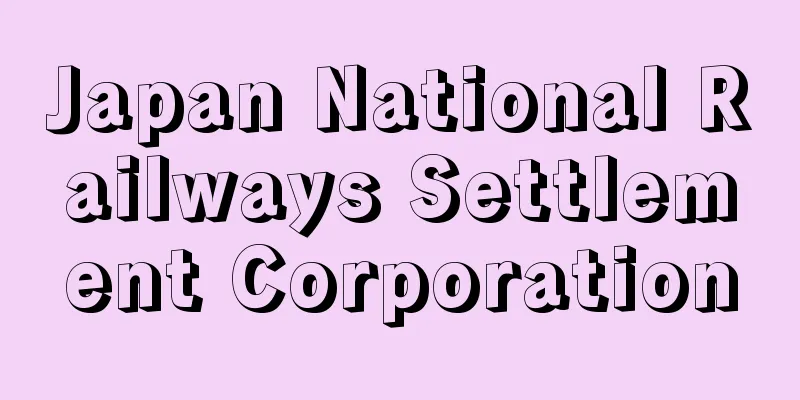Japan National Railways Settlement Corporation

|
This special corporation was established to handle the liquidation of the Japanese National Railways (JNR) when it was divided and privatized in April 1987. It was dissolved in October 1998. When the Japan National Railways Settlement Corporation (JNR Settlement Corporation, hereafter abbreviated as the Corporation) was established, the total debt of the former JNR was 37.1 trillion yen. The three JR companies in Honshu bore over 11.6 trillion yen of this, and the Corporation took over the remaining 25.5 trillion yen. The settlement plan at that time was for the public to pay 13.8 trillion yen, land to sell 7.7 trillion yen, stock to sell 1.2 trillion yen, and the Shinkansen Holding Corporation (dissolved in 1992) to pay 2.9 trillion yen. To repay the debt, the Corporation sold land it owned and some of its JR stock, earning about 1.5 billion yen in revenue. However, during the so-called bubble economy, the sale of land was frozen by cabinet decision due to the risk of fueling a rise in land prices, and high interest burdens could not be resolved. As a result, the outstanding balance of JNR's long-term debt ballooned to about 28 trillion yen (as of the end of fiscal 1997), and debt repayment did not progress in real terms. Another of the Corporation's tasks was to promote the reemployment of former JNR employees. When JNR closed its doors after 115 years of history, there were 277,000 JNR employees. Of these, approximately 200,000 were newly hired by JR companies and other organizations. At this point, some employees left JNR, but approximately 24,000, including approximately 7,600 who had not yet found new employment, were transferred to the Corporation. The Corporation implemented measures to help employees find new employment, but in April 1990, it fired 1,047 members of the National Railway Workers' Union (Kokuro), who had demanded "local, in-house employment," and discontinued this task. Despite the continued increase in the debt balance, the remaining assets were decreasing, and it became difficult for the Corporation to repay the debt with its own financial resources. Therefore, the government formulated a debt disposal plan, and in the fall of 1998, submitted the "Former JNR Debt Disposal Bill" (Law Concerning the Disposal of Debts of the Japan National Railways Settlement Corporation) to the Diet. This bill called for the government to take over 24.2 trillion yen (the total of interest-bearing and non-interest-bearing debts at the time of the Corporation's dissolution) out of the former JNR's long-term debt, which totaled 28.3 trillion yen, and provided for the interest payments to be made through the creation of a special tobacco tax and transfers from the Postal Savings Special Account, and also required the three JR Honshu companies to make additional contributions to cover the shortfall in pension contributions. Despite opposition from JR and others, the bill was passed after much difficulty in October, and the Corporation was dissolved in October 1998. The remaining land and JR shares were taken over by the Japan Railway Construction Public Corporation (now the Japan Railway Construction, Transport and Technology Agency), and many of the employees were transferred to the Corporation to continue selling land. [Yasunori Doi] [References] | | | |Source: Shogakukan Encyclopedia Nipponica About Encyclopedia Nipponica Information | Legend |
|
1987年(昭和62)4月に日本国有鉄道(国鉄)が分割・民営化された際に、国鉄の清算業務を担当するために発足した特殊法人。1998年(平成10)10月、解散。日本国有鉄道清算事業団(略称国鉄清算事業団、以下、事業団と略記)発足時の旧国鉄債務総額は37兆1000億円であった。本州のJR3社がこのうちの11兆6000億円あまりを負担し、残り25兆5000億円を事業団が引き継いだ。その時点の処理案は、国民負担13兆8000億円、土地売却7兆7000億円、株式売却1兆2000億円、新幹線保有機構(1992年解散)負担2兆9000億円となっていた。 事業団は債務返済のため、所有土地の売却やJR株式の一部売却を行って約15億円の収入を得た。しかしいわゆるバブル経済期には地価高騰をあおる恐れがあるとして、閣議決定により用地の売却が凍結されたり、高い利子負担が解消できなかったりして、国鉄長期債務等残額は約28兆円に膨れあがり(1997年度末時点)、債務償還は実質的には進まなかった。 事業団のいま一つの業務に、旧国鉄職員の再就職の促進があった。国鉄が115年の歴史を閉じた時点で、国鉄職員は27万7000人いた。このうちの約20万人はJR各社等に新規採用された。この時点で国鉄を去っていった職員もあったが、再就職先未定者約7600人を含む約2万4000人が事業団に移された。事業団は再就職対策を実施したが、1990年(平成2)4月に「現地、現職採用」などを求めた国鉄労働組合(国労)組合員ら1047名を解雇し、この業務を打ち切っている。 債務残高が増加し続けているにもかかわらず、残る保有資産は減少し、事業団が自主財源によってその債務を償還するめどがたたなくなったため、政府は債務の処理方策を策定し、1998年秋に「旧国鉄債務処理法案」(日本国有鉄道清算事業団の債務等の処理に関する法律)を国会提出した。これは総額28兆3000億円の旧国鉄長期債務のうち、24兆2000億円(事業団解散時における有利子無利子債務の合計)を国が引き継ぎ、その金利支払いには、たばこ特別税新設や郵便貯金特別会計から繰り入れるとし、また年金負担額不足分をJR本州3社に追加負担を求めるなどの内容であった。JRなどの反対があったが、困難の末10月に成立し、1998年10月に事業団は解散、残余の土地とJR株式は日本鉄道建設公団(現鉄道建設・運輸施設整備支援機構)が引き継ぎ、職員の多くも公団に移って土地売却を続けることとなった。 [土居靖範] [参照項目] | | | |出典 小学館 日本大百科全書(ニッポニカ)日本大百科全書(ニッポニカ)について 情報 | 凡例 |
<<: Japanese National Socialist Party
>>: Japanese National Railways
Recommend
Ilija Garašanin
1812‐74 Serbian politician. During the reign of Pr...
Gantt Chart
A "Gantt chart" is a table used for sche...
Cutting - Sessaku
In a broad sense, it includes processing using abr...
Sen Sotan
1578-1659 * A tea master from the early Edo perio...
Bragança - Bragança (English spelling)
It is the central city of the Tras os Montes i Al...
Liutprand (English spelling)
[Birth] Around 920 [died] about 972 Italian histor...
Okawado Mikuriya (Okawado Mikuriya)
A mikuriya in the territory of Ise Jingu, whose re...
nail
…The claws on the front paws of moles are broad a...
Dientzenhofer, J.
…A family of late Baroque architects active in Ba...
Phalacrocorax pelagicus
…Cormorant Fishing [Kiyomitsu Sasaki]. … *Some of...
Ministry of Labor - Labor
It is a national administrative agency establishe...
Urajio - Urajio
...It is 999m above sea level, and National Route...
Aoya [town] - Aoya
A former town in Keta County, central Tottori Pref...
Epiphytes - Epiphytes
Epiphytes are plants that attach themselves to th...
Long distance fare reduction - enkyori teigen unchin
…Due to the above circumstances, what has come in...









